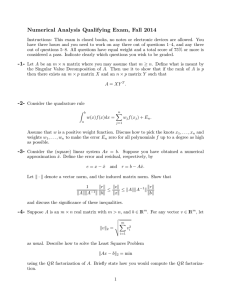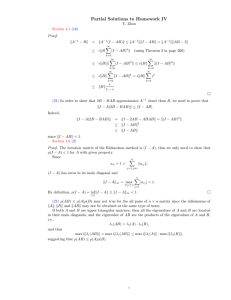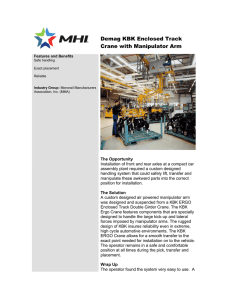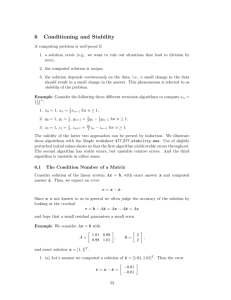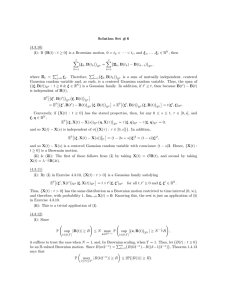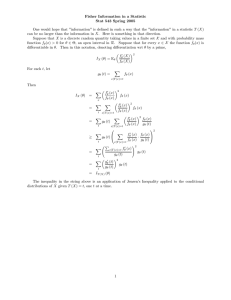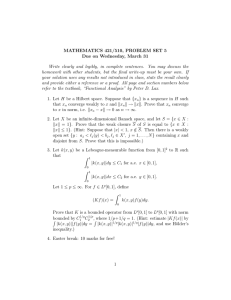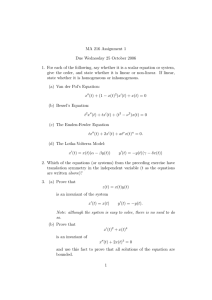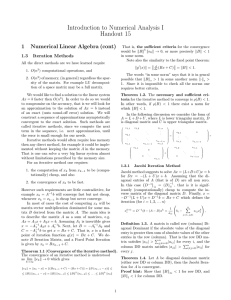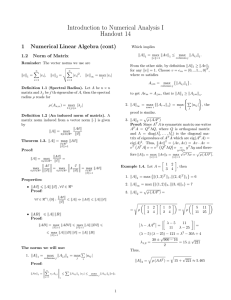Math 3220 § 1. Second Midterm Exam Name: Solutions
advertisement
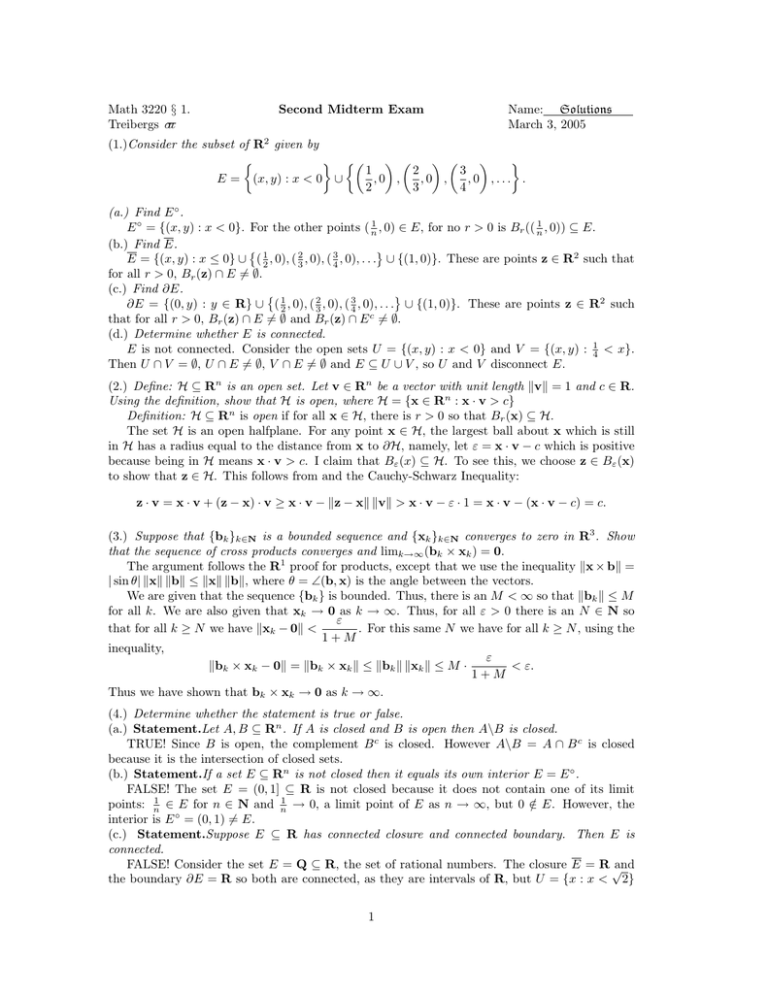
Math 3220 § 1.
Treibergs σ−
ιι
Second Midterm Exam
Name: Solutions
March 3, 2005
(1.)Consider the subset of R2 given by
2
3
1
,0 ,
,0 ,
,0 ,... .
E = (x, y) : x < 0 ∪
2
3
4
(a.) Find E ◦ .
E ◦ = {(x, y) : x < 0}. For the other points ( n1 , 0) ∈ E, for no r > 0 is Br (( n1 , 0)) ⊆ E.
(b.) Find E.
E = {(x, y) : x ≤ 0} ∪ ( 12 , 0), ( 23 , 0), ( 43 , 0), . . . ∪ {(1, 0)}. These are points z ∈ R2 such that
for all r > 0, Br (z) ∩ E 6= ∅.
(c.) Find ∂E.
∂E = {(0, y) : y ∈ R} ∪ ( 12 , 0), ( 23 , 0), ( 34 , 0), . . . ∪ {(1, 0)}. These are points z ∈ R2 such
that for all r > 0, Br (z) ∩ E 6= ∅ and Br (z) ∩ E c 6= ∅.
(d.) Determine whether E is connected.
E is not connected. Consider the open sets U = {(x, y) : x < 0} and V = {(x, y) : 41 < x}.
Then U ∩ V = ∅, U ∩ E 6= ∅, V ∩ E 6= ∅ and E ⊆ U ∪ V , so U and V disconnect E.
(2.) Define: H ⊆ Rn is an open set. Let v ∈ Rn be a vector with unit length kvk = 1 and c ∈ R.
Using the definition, show that H is open, where H = {x ∈ Rn : x · v > c}
Definition: H ⊆ Rn is open if for all x ∈ H, there is r > 0 so that Br (x) ⊆ H.
The set H is an open halfplane. For any point x ∈ H, the largest ball about x which is still
in H has a radius equal to the distance from x to ∂H, namely, let ε = x · v − c which is positive
because being in H means x · v > c. I claim that Bε (x) ⊆ H. To see this, we choose z ∈ Bε (x)
to show that z ∈ H. This follows from and the Cauchy-Schwarz Inequality:
z · v = x · v + (z − x) · v ≥ x · v − kz − xk kvk > x · v − ε · 1 = x · v − (x · v − c) = c.
(3.) Suppose that {bk }k∈N is a bounded sequence and {xk }k∈N converges to zero in R3 . Show
that the sequence of cross products converges and limk→∞ (bk × xk ) = 0.
The argument follows the R1 proof for products, except that we use the inequality kx × bk =
| sin θ| kxk kbk ≤ kxk kbk, where θ = ∠(b, x) is the angle between the vectors.
We are given that the sequence {bk } is bounded. Thus, there is an M < ∞ so that kbk k ≤ M
for all k. We are also given that xk → 0 as k → ∞. Thus, for all ε > 0 there is an N ∈ N so
ε
that for all k ≥ N we have kxk − 0k <
. For this same N we have for all k ≥ N , using the
1+M
inequality,
ε
kbk × xk − 0k = kbk × xk k ≤ kbk k kxk k ≤ M ·
< ε.
1+M
Thus we have shown that bk × xk → 0 as k → ∞.
(4.) Determine whether the statement is true or false.
(a.) Statement.Let A, B ⊆ Rn . If A is closed and B is open then A\B is closed.
TRUE! Since B is open, the complement B c is closed. However A\B = A ∩ B c is closed
because it is the intersection of closed sets.
(b.) Statement.If a set E ⊆ Rn is not closed then it equals its own interior E = E ◦ .
FALSE! The set E = (0, 1] ⊆ R is not closed because it does not contain one of its limit
points: n1 ∈ E for n ∈ N and n1 → 0, a limit point of E as n → ∞, but 0 ∈
/ E. However, the
interior is E ◦ = (0, 1) 6= E.
(c.) Statement.Suppose E ⊆ R has connected closure and connected boundary. Then E is
connected.
FALSE! Consider the set E = Q ⊆ R, the set of rational numbers. The closure E = R √
and
the boundary ∂E = R so both are connected, as they are intervals of R, but U = {x : x < 2}
1
√
and V = {x : x > 2} disconnect E: U and V are open sets in R such that U ∩ V = ∅, U ∩ E 6= ∅,
V ∩ E 6= ∅ and E ⊆ U ∪ V .
(5.) Suppose that a subset A ⊆ E ⊆ Rn . Show that A is relatively open in E if and only if the
condition (O.N.) holds:
(∀x ∈ A)(∃G ⊆ Rn : G is an open set )(x ∈ G ∩ E ⊆ A).
O.N.
A subset A is relatively open in E if there is an open set O ⊆ Rn such that A = O ∩ E.
Being relatively open trivially implies the condition (O.N.) If A is relatively open, let O ⊆ Rn
be the open set such that A = O ∩ E. Then for every x ∈ A, we may take G = O, because then
x ∈ A = G ∩ E ⊆ E satisfies the condition (O.N.)
Now to show that the condition (O.N.) implies that A is relatively open, we have to construct
an open set G ⊆ Rn so that A = G ∩ E. For each x ∈ AS let Gx ⊆ Rn be the open set in the
definition of (O.N.), such that x ∈ Gx ∩ E ⊆ A. Let G = x∈A Gx . As this is the union of open
sets, G is also open. With this set, I claim that A is relatively open, namely A = G ∩ E. To see
“⊇,” suppose that y ∈ G ∩ E. This means that there is an x ∈ A so that y ∈ Gx . But by the
construction of Gx and since y ∈ E we have y ∈ Gx ∩ E ⊆ A. To see “⊆,” choose z ∈ A. Again,
by the construction of Gx , z ∈ Gz ∩ E ⊆ G ∩ E, as G is the union of such sets.
2
